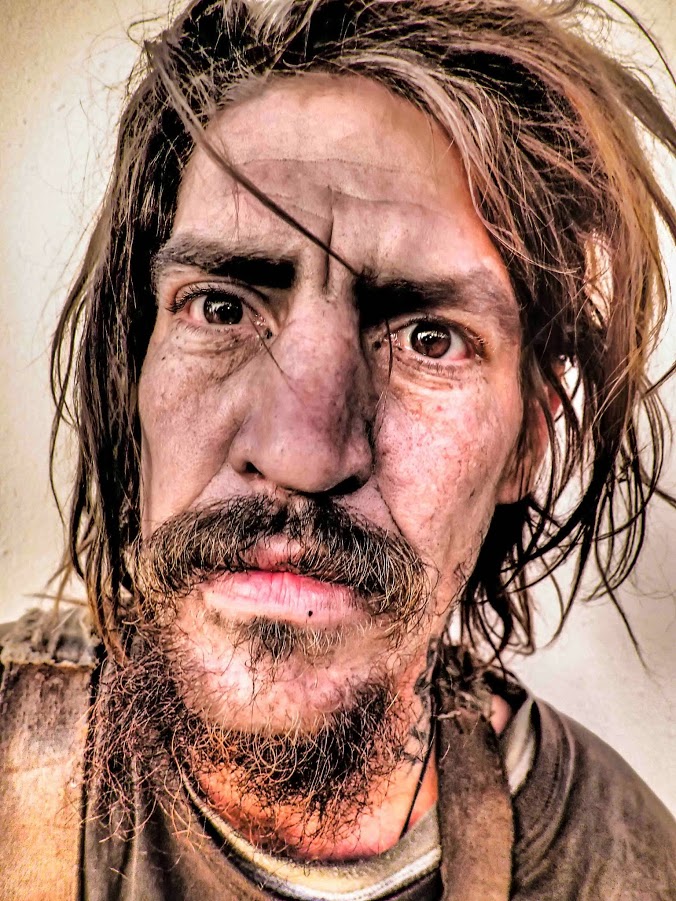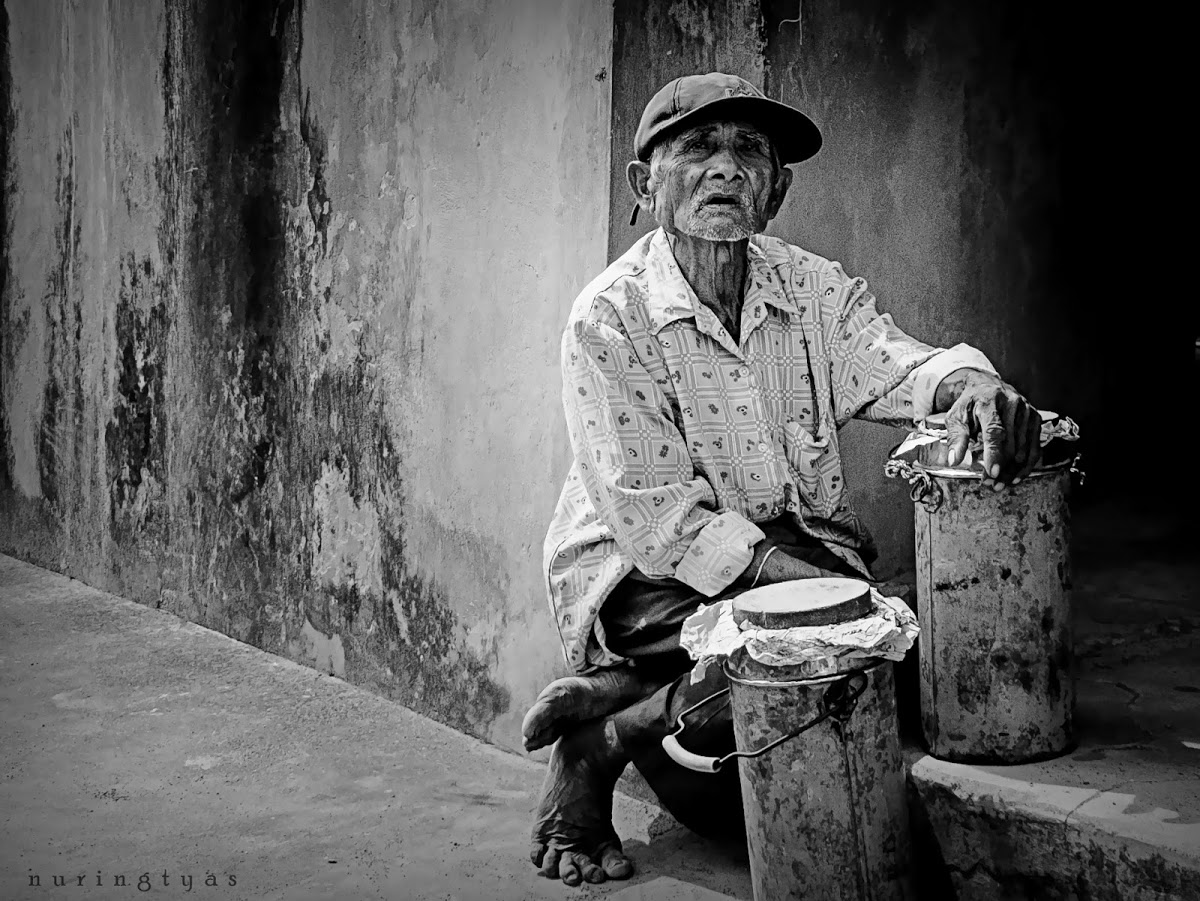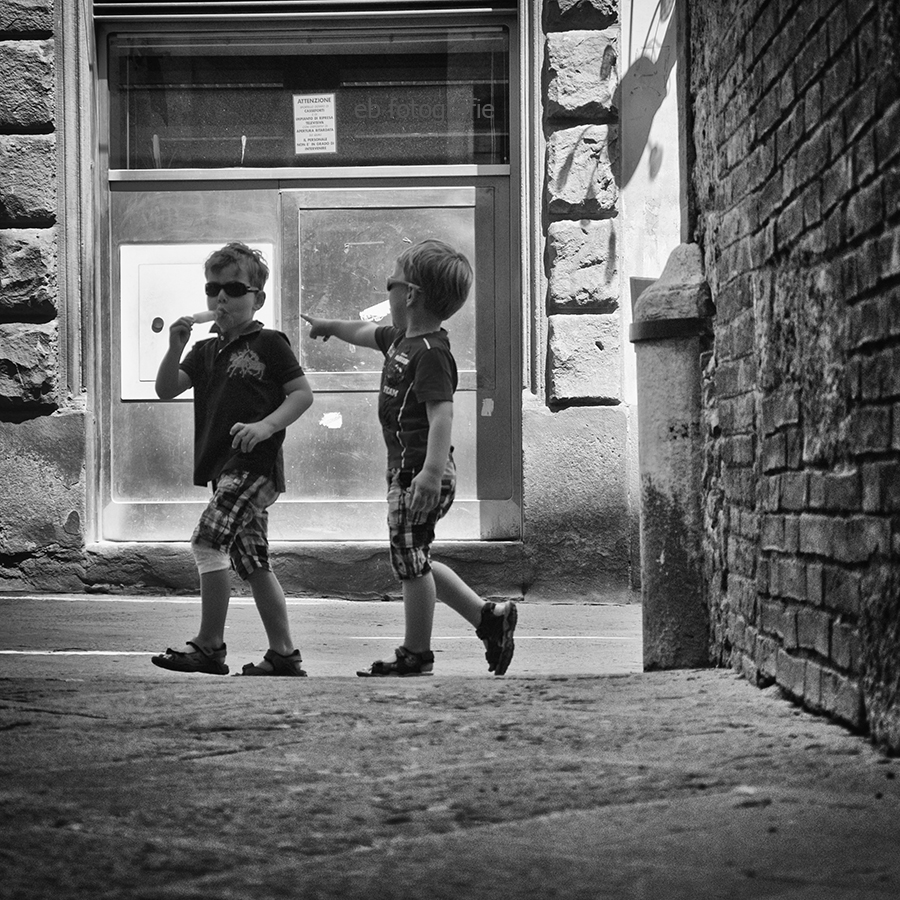Street Photography
Street Photography
This time I want to spend some words on Street Photography. As you might have noticed, it's my favourite kind of photography. On G+ a few followers asked me how to do proper Street Photography. Sad thing is: I don't know. So if you were looking for a tutorial on street photography I have to disappoint you...
What is Street Photography?
 In essence every kind of photography in a public place can be called Street Photography. Many photographers follow this "definition" but it just doesn't work for me.For me street photography is all about observing people and catching the moment.
In essence every kind of photography in a public place can be called Street Photography. Many photographers follow this "definition" but it just doesn't work for me.For me street photography is all about observing people and catching the moment.
You see people walking in the shadow of a building, knowing they will enter the light soon...
A couple discussing/quarreling.
An old man sitting on a bench.
Though people are the main subject, the surrounding or backdrop does matter to me too. A crowded shopping street is difficult to shoot in. The one interesting person will be surrounded by lots of other people.
One other thing is very important to me: the subject should not be posing for you unless it is done spontaneously. I never ask a person on the street to pose for me. I never ask permission. For me it's all about the moment, the scene, the feeling. It's very difficult to get that when people are posing.
Having said that, you just have to take a look at the work of T. Bowden (link is at the bottom of this article).
 Most of the people he photographs pose for him. To me he has a kind of sixth sense for special people. His pictures are about stories of the people. His heavy processing emphasizes their characters. After seeing his images you will probably have second thoughts on what I wrote just before...
Most of the people he photographs pose for him. To me he has a kind of sixth sense for special people. His pictures are about stories of the people. His heavy processing emphasizes their characters. After seeing his images you will probably have second thoughts on what I wrote just before...
T. Bowden, The Drifter

Another friend of mine: tri rini nuringtyas (link also below). She does all kinds of photography but, for me, she excells in street journalism. This is a kind of street photography I hope to master before I die. In her photographs she tells complete stories. She talks to the people to hear their story. She engages and gets involved. Very remarkable!
Tri rini nuringtyas, Ice lolly man
So, if you really want to know what street photography is, you'll just have to get your @$$ up on the streets and look! Most important thing I want to state here: be true to yourself and to the people you photograph. Don't go sneaking around in the bushes with large telephotos. Give people at least the chance to spot you. You see them, don't be afraid of them seeing you!
As you can tell by the different images shown in this article there are all kinds of street photography. T. Bowden shows his interest in people by taking portraits of them. Sometimes I wonder if the images were even taken outside. Tri rini nuringtyas will most likely place her subjects noticeably in their natural surroundings. This is her way to let people tell their story.
There is no bad or good street photography as long as it serves your way of story telling. I think a photographer (in general) should try to tell a story with his images. A viewer has to be encouraged to explore the image, to have questions.
How to
Is there something to say about the "best" camera settings for street photography?
Well, I guess it's a matter of taste and circumstances. Personally I want to make sure the subject will be imaged as sharp as possible. This means I have to use a small aperture like f/8 (see my tutorial...). On the other hand, cities can be darker than you might think. So a small aperture could cause a slow shutter speed. Always check if the speed is right. A rule of thumb I use: if you use a focal length of 50mm, the shutter speed should be 1/50s at least (1/60s). With a focal length of 200mm you use a shutter speed of 1/200s (1/250). Slower shutter speeds will blur your image.
So: keep the exposure triangle in mind and adjust your ISO if needed.
But what about DoF? A shallow depth of field can be really nice in Street Photography right? Yes it can!
But keep in mind: your subject is most likely moving. Between the moment your camera locks the focus and you release the shutter he (she) most likely will be out of focus... If you use a fast lens, let's say a 50mm-f/1.4 it's very difficult to take a sharp picture of someone close by at f/1.4. However, if you use a telephoto, let's say a 300mm, you don't have to get close, it will be easier to focus and you can use a smaller aperture and still get your nice DoF...
Do's and dont's
As I mentioned before: I don't like it when people are posing for me. So I will not ask people if it's okay to take a picture of them. Of course, there are always exceptions.
The main topic talked about in Street Photography is The Law. What is allowed, what isn't. Well, of course, it depends on where you are/live. In Europe it's okay to take pictures of people in public places. It's okay to take pictures of children as well.
As a photographer you are the artist and you own all rights of the pictures you take. Unless...
Unless you're harming people by publishing a picture. If you took a picture of someone in an awkward position and you publish it you might get into trouble... If you take a picture of someone and by publishing it you create financial damage to that person you might get into trouble. This is the case if you photograph a celebrity for instance. He or she earns a living just because of his or hers image...
For me it's all about common sense. You know when it's okay or not. Act like it!
Why is SP mostly done in B/W?
Most street photography is done in cities. In most cities there are lots of billboards, lights, colours. This all will distract the viewer. Taking the image in black and white (or converting it to black and white afterwards) enables you to get the viewer to look at the subject. Sometimes you'll have to tweak the contrasts or desaturate some colours.
One other explanation might be nostalgia. Great photographers like Henry Cartier-Bresson shot black and white. And black and white gives you the opportunity to focus on contrasts and structures. I think that's important in street photography because it gives your picture something timeless.
Places to go?
Personally I like to visit cities. People busy with doing whatever, not paying any attention, living their own lives. Of course you could go where ever you want. For me it's important there are people.
Light to seek...
In model or fashion photography you're in control of the light, in street photography you're not. Lot's of people think: the more light the better. Well, it depends. If you want to take an image of an old man or woman with wrinkles and all you might be right. Just remember: A cloudless day with harsh sunlight will give you sharp and harsh shadows. An overcast day on the other hand will flatten everything. For me a late afternoon, long shadows, a cloud now and then will do perfectly. Look for the light that fits your subject... Yes, easier said than done; I guess you'll have to click and see...
People and what about children?
As I mentioned before: street photography is mostly done in black and white. For me there is one exception: children. If you take pictures of children there should be some colour in your image. At least, that is my opinon.
The real question you ask here is: Is it appropriate to take pictures of children?
 To be honest: I don't have the right answer to that. I wouldn't take pictures of children in the schoolyard or at the pool. I don't have any problems with shooting children in the city. I know there are countries like the U.S. with laws that forbid you to take pictures of children. Be sure you check on the laws in the country you shoot. Use your common sense!
To be honest: I don't have the right answer to that. I wouldn't take pictures of children in the schoolyard or at the pool. I don't have any problems with shooting children in the city. I know there are countries like the U.S. with laws that forbid you to take pictures of children. Be sure you check on the laws in the country you shoot. Use your common sense!
The picture on the left is one of the rare photographs I took of children. I posted myself in the alley and waited until the boys came into the frame. With this light it's hard to tell who they are but the story (two boys arguing) is clear. In cases like this I don't mind taking and publishing pictures of children.
Special thanks to:
Thank you Tri rini nuringtyas so much for letting me use a picture of yours.
And T. Bowden thank you very much for helping me out.
For both of you: I'm very glad to have you as a G+ friend. I'm learning a lot of your work!
Interesting photographers
Brassaï
Henry Cartier-Bresson
Robert Frank
Find a huge list of photographers here
Last minute...
Not all countries allow street photography: Hungary: Taking photos without permission is illegal
For now...
I hope you liked this article. If so: spread the word by plussing and sharing.
If you have any questions or comments you can leave them below.
For now: Have a good one and use the light to write!